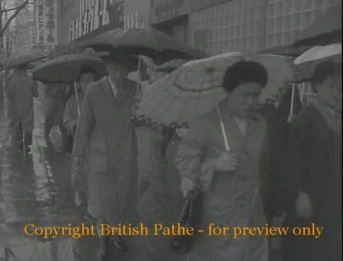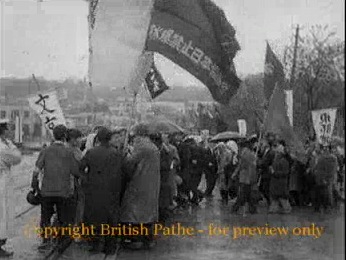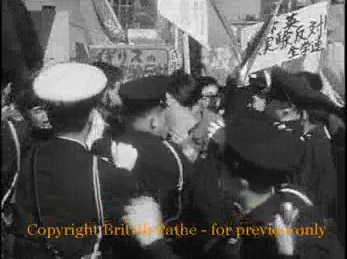Footage from the following three short newsreels were selected in order to show the prevailing anti-nuclear sentiment in parts of the Japanese public during the 1950s and 1960s. At the height of the protests against the Treaty of Mutual Cooperation and Security between the United States and Japan (anpo jōyaku) in 1960, hundreds of thousands of Japanese took their anger to the streets in front of the National Diet. Considering such background, it may be hard to grasp at first why relatively few protesters have rallied against nuclear energy during the height of the Fukushima nuclear crisis so far. To put things into perspective, in the period of time immediately preceding Fukushima, fewer than 50 people would have typically demonstrated at any given time; the demonstrations of 10 April 2011, in which approximately 17,500 people marched in Tokyo and elsewhere in Japan, thus marks a dramatic increase. However, comparing contemporary demonstrations with those seen in the newsreel footage shown here, or with concurrent demonstrations in Germany this spring that have attracted 250,000 protesters, Japan’s protest movement remains comparatively small. How did what seems a largely uncritical acceptance of nuclear energy in Japan come to the fore? –Christian Dimmer
British Pathé. 1957. Atom Fear Stirs Japan. Video, from British Pathé video film archive, http://www.britishpathe.com/record.php?id=66625
Opening with the remarkable line, “radioactive rain brings new fears to atom-conscious Japan,” this snippet shows the strong public concern over British and Russian nuclear tests that have caused radioactive rain in Japan. Over 15,000 protest in front of the British embassy and umbrellas become a sales hit.
British Pathé. 1957. Jap Protest. Video, from British Pathé video film archive, http://www.britishpathe.com/record.php?id=32824
“Stop the tests,” demonstrators in Tokyo demand in the aftermath of American and Russian nuclear tests. The strong anti-nuclear sentiment is further heightened by Britain’s announcement to also begin with hydrogen bomb tests. Subsequently, protests by “Japs,” as the announcer describes (a term that gained a derogatory connotation during World War II, now considered an ethnic slur), are staged in front of the American, Russian and British embassies in Tokyo.
British Pathé. 1962. Ban The Bomb Demonstration in Tokyo. Video, from British Pathé video film archive, http://www.britishpathe.com/record.php?id=62269
Various scenes show a small group of students who protest the United State’s plan to resume nuclear tests in the atmosphere. The political bias of this Cold War newsreel is noted by the caricature of the demonstrators in which “leftists protest atom tests,” resisting the police with “fanatical left-wing zeal.”
![[Teach311 + COVID-19] Collective](https://blogs.ntu.edu.sg/teach311/files/2020/04/Banner.jpg)


